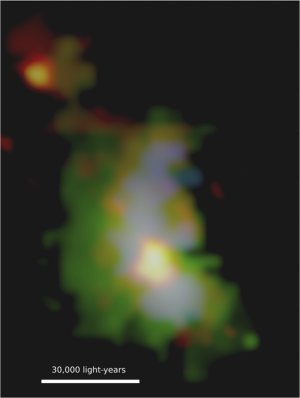Turning off the Lights [1]
A supermassive black hole appears to be “blowing out the candles” in its home galaxy. It’s producing a strong wind that’s blowing away the gas around it, shutting down the birth of new stars.
A team led by Shelley Wright of the University of California-San Diego used telescopes on the ground and in space to study a galaxy known as 3c 298. It’s more than nine billion light-years away. That means we see the galaxy as it looked more than nine billion years ago, when the universe was just a third of its present age. And the galaxy is merging with a smaller galaxy.
The heart of 3c 298 contains a black hole that’s a few billion times the mass of the Sun. The black hole is surrounded by a disk of gas that’s spiraling into the black hole. As it gets close, the gas is heated to extreme temperatures, so the disk shines brilliantly. That creates a quasar — one of the brightest objects in the universe.
Observations of 3c 298 show that huge amounts of gas are moving away from the quasar — enough to make thousands of Sun-sized stars every year. The gas appears to be pushed by jets of particles that are shooting out from the poles of the black hole. The jets create strong winds that blow through the entire galaxy. At least for a while, this “feedback” from the black hole will limit the number of stars that are born in the heart of this young, busy galaxy.
Script by Damond Benningfield


